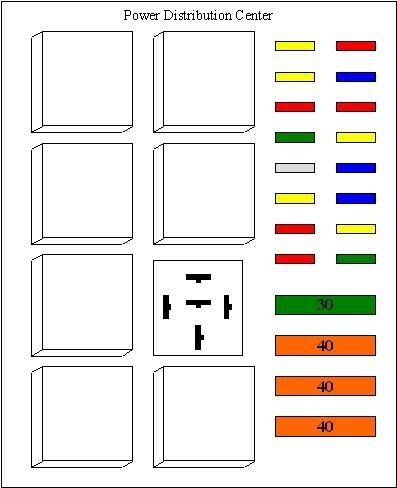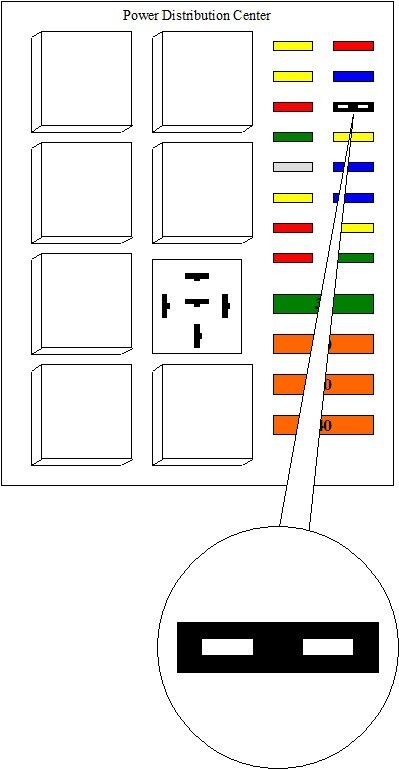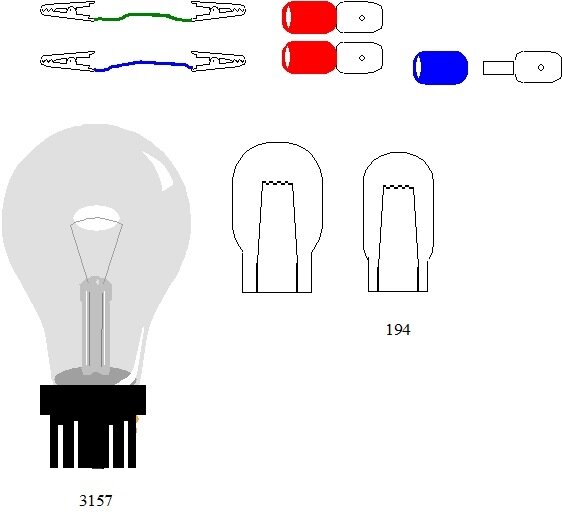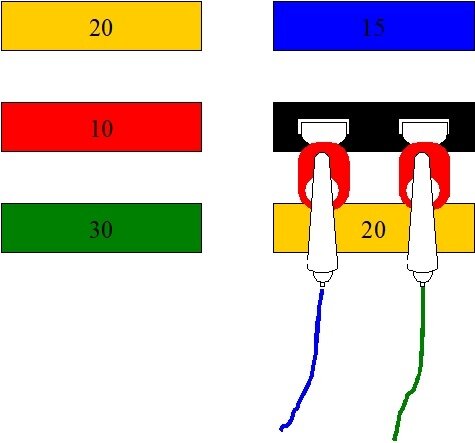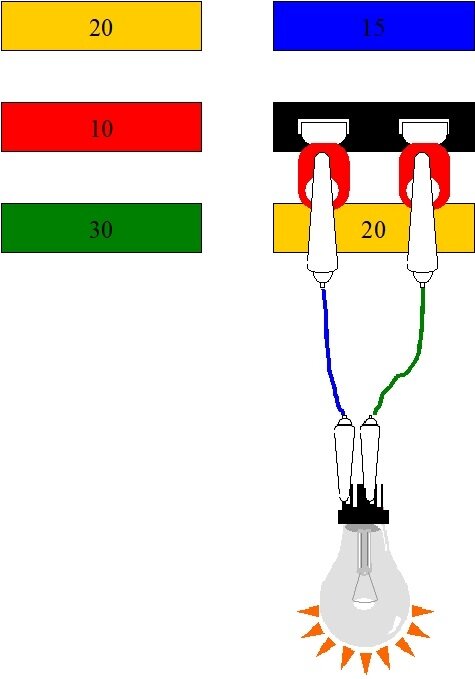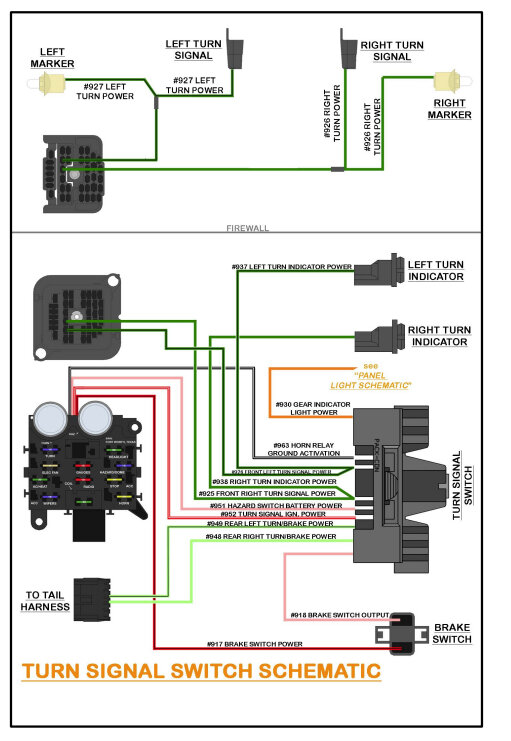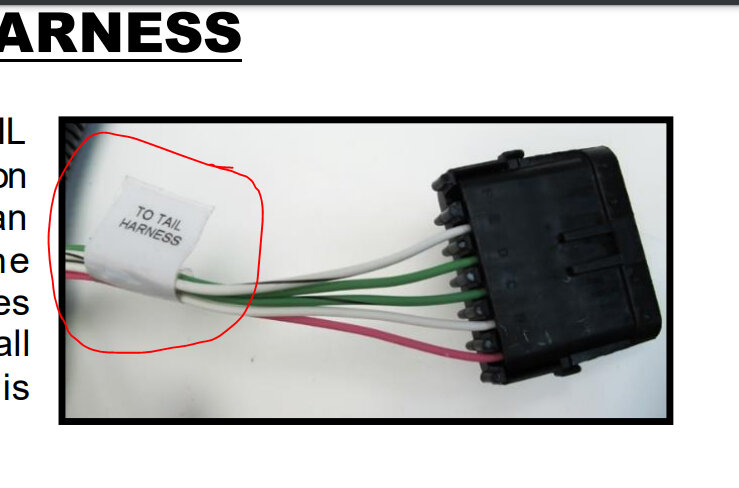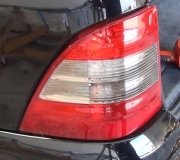Without seeing a wiring diagram, I'm confused, (not arguing), of how you narrowed this down. If the short is between the fuses and a switch, the fuse should blow right away. With your dandy observation the fuses don't blow until a switch is activated tells me the short has to be after that switch.
Regardless, here's a trick that will let you get started without wanting to buy stock in a fuse manufacturer's company. You're a few steps ahead already with the parts you listed, so some of this is a repeat for the benefit of others researching this topic. Bare with me if some of this is already obvious to you.
The first drawing shows a typical under-hood fuse box with a relay removed. This procedure works just as well with relays or with fuses.
In the second drawing, the blown fuse has been removed.
The items needed are shown in the third drawing. The easiest way to connect the bulb is with a pair of clip leads and a pair of generic, universal spade-type terminals. You can find a dozen clip leads for about three dollars at Harbor Freight Tools. These are available in different sizes. Stick with the smallest ones to insure the alligator clip will fit inside the terminal.
To buy the terminals, you'll end up buying a box of typically 50 or more. Instead, any electronic hobbyist will have many of these lying around. The spade end should be no fatter than the mating terminals for the relay or fuse. It's common for the wire end to be too small in diameter for the alligator clip to fit in. The blue terminal has the insulating barrel removed by twisting it off. Now just stick the terminals in that way, and clip the alligator clips to them. The fourth drawing shows the terminals inserted in the fuse's socket. In the fifth drawing, a clip lead has been connected to each terminal.
Finally, in the sixth drawing, the bulb is connected. In this type of circuit, it may be powered up now, and if the short is present, the bulb will be full brightness. Bulbs get real hot and will melt plastic and carpeting, so be careful where you set it. The bulb could also be dim or off. If it's dim, the short is not present right now. Some current is flowing if the test bulb is dim. If the bulb is off, no current is flowing because everything on the circuit is switched off. In either of those last two cases, the bulb will flash full brightness if you do something to make the intermittent short occur. Tap around the vehicle with a rubber hammer, and move wire harnesses around to see what makes the short show up.
At this point it is almost required to know what is on the circuit so you'll know what to disconnect and where to look. If your new harness has other connectors along its route, disconnect them to see what takes the short out of the circuit. With your solid short, the intermittent part of this story doesn't apply. That makes it better for us because we'll know as soon as we find and remove the short. When you do something to remove the short, the test bulb will dim or go out. When the short is present and the circuit is powered up, the test bulb will limit current to a safe one amp or less.
A final word about the test bulbs. Because they limit current flow, even when the short is located and removed, items on that circuit will not operate. Most of the 12 volts in the circuit will be "dropped" across the bulb, leaving very little left for the rest of the circuit. Fan and seat motors will be totally dead until the fuse is reinstalled. In low-current lighting circuits such as for tail lights, you might see a dim glow in some of the vehicle's bulbs. They too will be normal full brightness once the test bulb is no longer in the circuit.
If you should do this in a high-current circuit such as for a heater or radiator fan motor, due to the big difference in resistance between the motor and the test bulb, most of the 12 volts will be dropped across the test bulb, so it will still appear to be bright. There may be only one or two volts dropped across the motor, so it's not going to run, even slowly. The secret here is to watch the brightness of the test bulb very closely. When the short is removed, the test bulb will dim so slightly that you can only see it as it happens.
If you aren't confident yet the short has been removed in a high-current circuit, use a larger bulb in place of the fuse. A common 9004 headlamp bulb will pass up to five amps on "low", and around six amps through the high beam filament. That can be enough to see a fan motor at least try to run very slowly. That movement and the less-than-full-brightness of the test bulb would prove the short is gone.
If you use a headlamp bulb in the vehicle's headlamp circuit, when the short is gone, you'll see the test bulb will be less than full brightness, and the headlights will be on but dim. If you unplug one headlamp, the remaining one and the test bulb will each drop roughly half of the 12 volts, so both will be dim and close to the same brightness. Of course once you find and remove the short, you probably won't care about going any further.
To get back to your new harness, we're likely not looking for a section that fell down onto hot exhaust parts or is draped across the sharp edge of a metal bracket. Being new, something is wired incorrectly, it's for the wrong application, or something is connected to the wrong place. Let me know what you find up to this point. If you have a diagram that came with the new harness, try to post a photo of it. Like a road map to a trucker, diagrams to me mean more than words.
Images (Click to make bigger)
Saturday, April 29th, 2023 AT 8:19 PM
